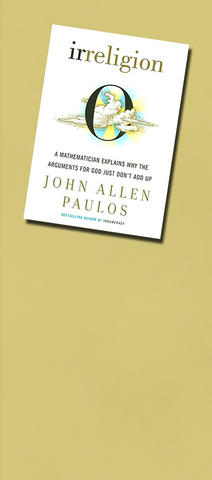Sam Harris' 2004 book, The End of Faith: Religion, Terror and the Future of Reason, set off a noisy boomlet of anti-religion books, including Richard Dawkins' provocative if preachy tome, The God Delusion, and Christopher Hitchens' furious (and often very funny) jeremiad, God Is Not Great: How Religion Poisons Everything. These books provided a vehement response to the growing influence of evangelicals in American politics and the raging fires of fundamentalism around the world, and they even led to talk about the stirrings of a "new atheist" movement.
At their best, these books performed the valuable service of reminding readers how far some politicians have departed from the Enlightenment values of the founders and the principle of separation of church and state - particularly at a time when Mike Huckabee, a leading Republican contender in the US' presidential race, has called for the Constitution to be amended so that it can be brought in line with "God's standards."
At their worst, these books simply spewed invective against religion, helping to ratify believers' accusations that atheists and agnostics lack respect for others' convictions (something believers are frequently guilty of themselves).

The latest entry in the God wars is Irreligion by John Allen Paulos, the mathematician best known for his best-selling book Innumeracy. In this hasty and very lumpy volume Paulos proposes to expose the irrational basis of religious thinking, much the way he exposed rampant mathematical illiteracy in Innumeracy, this time providing some brisk refutations of the greatest-hits arguments for God, from "the golden oldies of religious thought to those with a more contemporary beat."
The volume gets off to a bracing start, deftly dismantling creationist arguments that the astonishing complexity of life could have come about only through the efforts of a master designer, by succinctly showing how Darwin's theory of natural selection and free-market economics provide well-confirmed alternative explanations for the evolution of complex systems.
Writing in clear, direct prose, Paulos shows how even everyday references to purpose and intention can be easily reformulated in scientific, non-purposive terms. For instance, "The thermostat is trying to keep the house at a steady temperature" can be rephrased in terms of metals' different rates of expansion: "When it gets hot, this metal expands faster than the other one and tips a switch turning the furnace off, and when it gets cool, the metal contracts faster, turning the furnace back on. No one is really attributing intentionality to the metals."
In his opening chapters Paulos uses simple logic to point up the gaping holes in the so-called first-cause argument. "Either everything has a cause, or there's something that doesn't," he writes. "The first-cause argument collapses into this hole whichever tack we take. If everything has a cause, then God does, too, and there is no first cause. And if something doesn't have a cause, it may as well be the physical world."
What's more, he notes, "the uncaused first cause needn't have any traditional God-like qualities. It's simply first, and as we know from other realms, being first doesn't mean being best. No one brags about still using the first personal computers to come on the market. Even if the first cause existed, it might simply be a brute fact - or even worse, an actual brute."
As the book progresses, however, Paulos' writing becomes increasingly technical and increasingly jokey, and his reasoning becomes more and more difficult for the non-mathematician to follow. His repudiation of the ontological argument for the existence of God, for instance, is based on a reductive, paper-tiger summation of the argument itself: God is "the greatest and most perfect possible being"; this "most perfect being must possess all characteristics of perfection"; and "since it's better to exist than not to exist, existence is a characteristic of perfection." Hence, "God exists by definition."
Similarly, Paulos' argument that "doubt that God exists is almost banal in comparison to the more radical doubt" that people "exist, at least as anything more than nominal, marginally integrated entities having convenient labels like Myrtle and Oscar" is hardly persuasive. After all, how many readers who aren't college students having stoned, late-night conversations want to debate whether or not they exist themselves?
As for Paulos' discussion of the contradictions involved in a deity being both omnipotent and benevolent, it consists of little more than regurgitation of the Epicurus aphorism to the effect that if God is willing to prevent evil but unable to, then he is not omnipotent; that if he is able to but unwilling, then he is malevolent; and that if he is both able and willing to prevent evil, then there is no explanation for evil's continued existence.
Although Paulos begins Irreligion by promising that he will not use any hard-to-follow scientific formulas to make his case, he soon leads the reader deep into the mathematical wilderness by talking about things like the "Boolean satisfiability problem" and "combinatorial identities" and posing annoying paradoxes that do little but remind the reader of the ordeal of taking the SATs. ("What is the smallest number of guests who need be present so that it will be certain that at least three of them will know each other or at least three of them will be strangers to each other?")
In the course of this volume Paulos does provide some interesting asides about the so-called "confirmation bias, a psychological tendency to seek confirmation rather than disconfirmation of any hypothesis we've adopted, however tentatively" (which would seem to have applications to the Bush administration's use of intelligence in the prelude to the Iraq war). And he also does an entertaining job of applying probability theory to people's talk about miracles and amazing coincidences, which they've taken as evidence of the existence of God.
Still, there is something perfunctory and hurried about all of Paulos' arguments, which will be shrugged off by anyone who has made the leap of faith into belief, and which will seem obvious to anyone who is already a proud heathen. Indeed, the reader finishes this volume with the suspicion that it was a rushed and cursory project, turned out quickly in an effort to catch the coattails of Hitchens, Dawkins and Harris.

The Taipei Times last week reported that the rising share of seniors in the population is reshaping the nation’s housing markets. According to data from the Ministry of the Interior, about 850,000 residences were occupied by elderly people in the first quarter, including 655,000 that housed only one resident. H&B Realty chief researcher Jessica Hsu (徐佳馨), quoted in the article, said that there is rising demand for elderly-friendly housing, including units with elevators, barrier-free layouts and proximity to healthcare services. Hsu and others cited in the article highlighted the changing family residential dynamics, as children no longer live with parents,

The classic warmth of a good old-fashioned izakaya beckons you in, all cozy nooks and dark wood finishes, as tables order a third round and waiters sling tapas-sized bites and assorted — sometimes unidentifiable — skewered meats. But there’s a romantic hush about this Ximending (西門町) hotspot, with cocktails savored, plating elegant and never rushed and daters and diners lit by candlelight and chandelier. Each chair is mismatched and the assorted tables appear to be the fanciest picks from a nearby flea market. A naked sewing mannequin stands in a dimly lit corner, adorned with antique mirrors and draped foliage

The election of Cheng Li-wun (鄭麗文) as chair of the Chinese Nationalist Party (KMT) marked a triumphant return of pride in the “Chinese” in the party name. Cheng wants Taiwanese to be proud to call themselves Chinese again. The unambiguous winner was a return to the KMT ideology that formed in the early 2000s under then chairman Lien Chan (連戰) and president Ma Ying-jeou (馬英九) put into practice as far as he could, until ultimately thwarted by hundreds of thousands of protestors thronging the streets in what became known as the Sunflower movement in 2014. Cheng is an unambiguous Chinese ethnonationalist,

I was 10 when I read an article in the local paper about the Air Guitar World Championships, which take place every year in my home town of Oulu, Finland. My parents had helped out at the very first contest back in 1996 — my mum gave out fliers, my dad sorted the music. Since then, national championships have been held all across the world, with the winners assembling in Oulu every summer. At the time, I asked my parents if I could compete. At first they were hesitant; the event was in a bar, and there would be a lot